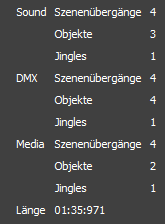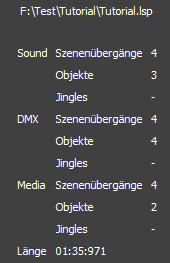menu: (

 |
Here the entire project is exported. This corresponds to saving a project with a crucial difference: When saving a project, all sound/media files used remain in place. This means that the sound/media files can be distributed over the computer. When exporting, all sound/media files are copied to a subfolder 'SoundFiles'/'MediaFiles' of the export folder. If the exported project is loaded, the sound/media files from the subfolder 'SoundFiles'/'MediaFiles' are used. When exporting the entire project, all lamps, universes, scenes, ... are stored, regardless of whether they are used or not. When you reload or import this export, the entire project is restored or integrated into an existing project. The exported project (or the folder where the exported project is located) can be ported to another computer. You can also overwrite the currently loaded project with the export. Thus, the current project becomes a portable project. |
 |
Only the selected objects are exported from the timeline. The sound files used in these objects are copied to a subfolder 'SoundFiles'. The media files used in these objects are copied to a subfolder 'MediaFiles'. Only the lamps, scenes, universes that are used in these selected objects are stored. The DMX hardware (USB-DMX-Interfaces, ...) is not saved, also the created mixing consoles are not saved. When you load such an export, the selected objects from the Timeline (and Jingles - see below) are restored with their necessary resources. This is suitable, e.g. often used light sequences or sound objects and to import them into other projects. |
 |
If you export only the selected objects, you can specify whether the jingles are to be exported or not. |
 |
A small statistic is displayed, which provides information about the objects to be exported and their length in the timeline. |
 |
Here you can enter a short description / note of the export. |
| Opens a file selection window where you can enter the location / folder for export. | |
| Discards the Export. |

| This opens a file selection window where you can select a project to be imported. | |
 |
As soon as a file has been opened, a small statistic about its content is displayed. |
 Original position of the imported objects Original position of the imported objects |
The objects are inserted into the same position as they were when they were exported. |
 at the sound cursor at the sound cursor |
The objects are inserted at the positionh of the sound cursor |
 at the light cursor at the light cursor |
The objects are inserted at the positionh of the light cursor |
 at the media cursor at the media cursor |
The objects are inserted at the positionh of the media cursor |
 at the end of the project at the end of the project |
The objects are appended to the end of the project. |
| The import is started | |
| The import is canceled |